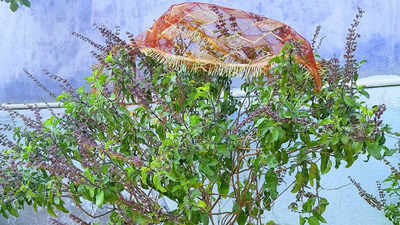Trending
Tulsi Vivah 2024: Exact date, timings for puja, significance, story, rituals, and all you need to know
Tulsi Vivah, a sacred Hindu tradition, celebrates the ceremonial marriage of Lord Vishnu and Vrinda, symbolized by the Shaligram and Tulsi plant. Observed on the Dwadashi tithi, this year it falls on November 13th, marking the beginning of the Hindu wedding season.

Tulsi Vivah also marks the start of the wedding season for Hindus which is paused during the Chaturmas, the four months when Lord Vishnu is in a deep slumber.
IPL 2025 Mega Auction
Correct date and timing for Tulsi puja and vivah
According to Drik Panchang, in 2024, Tulsi Vivah will be celebrated on “Tulsi Vivah - November 13, 2024, Wednesday
Dwadashi tithi ends - November 13, 2024, 01:01 PM”
The story behind Tulsi Vivah
The story and legend of Tulsi Vivah comes from the story of Vrinda, a devout wife who was married to Jalandhar, a rather evil King. According to beliefs, Vrinda was married to the demon king, and she was extremely devout and virtuous, and had complete faith in her husband. And even though Jalandhar was evil, Vrinda’s chastity and faith kept him undefeatable.
The gods, feeling threatened by Jalandhar’s power, asked for Lord Vishnu’s help. And so in an attempt to break Vrinda’s devotion, Lord Vishnu took Jalandhar's form and approached Vrinda, deceiving her into breaking her chastity. As a result, Jalandhar soon lost his power and was defeated by Lord Shiva in battle.
When Vrinda got to know about Lord Vishnu’s deceit and Jalandhar’s defeat, she was angry and furious on the Gods for tricking her. She cursed Lord Vishnu to turn into a black stone, the Shaligram, for betraying her faith. But Lord Vishnu could not punish a pure woman like her, and so he promised her that she would be reborn as the sacred Tulsi plant and that he would marry her every year in this form.

And so from then on, the Tulsi Vivah is done with Lord Vishnu in the Shaligram form, or with an image of Lord Vishnu or Lord Krishna, and the Tulsi plant that has been growing in the home.
For people who don't have a Tulsi plant at home, they either buy a new plant on the same day, or they visit the nearby temple to attend the celebration and festivities.
The importance and significance
Tulsi Vivah is celebrated for some very beautiful reasons in Hindu culture. It is a symbol of the divine union of Lord Vishnu and Goddess Lakshmi, embodied in the form of Tulsi, and it is also believed to be a symbol of how the Gods can and will never do any wrong towards the virtuous, righteous, and people who believe in themselves and their faith.
The day of Tulsi vivah also falls after Devuthani Ekadashi, and so the ritual marks the end of the monsoon season and the start of auspicious occasions, particularly weddings. And when new couples, or people wanting to get married perform Tulsi Vivah, they seek blessings for a prosperous and happy married life.
Tulsi vivah rituals

The rituals linked to Tulsi Vivah differ slightly across regions but have a similar structure.
First of all, the Tulsi plant, often kept in the aangan (courtyard) or near the home’s entrance, is decorated elaborately. The pot in which the Tulsi plant is grown is painted afresh, or even changed sometimes, and then decorated with traditional patterns and designs. The plant is also dressed as a bride, draped in a red or yellow saree and chunni, with small pieces of jewelry and colourful bangles over the twigs and branches.
Next to the plant, a small idol or photo of Lord Vishnu or Lord Krishna is kept, but some devotees also choose to keep the Shaligram stone itself.
The area around the Tulsi plant is decorated with rangoli, flowers, lights, and more, to give it the perfect wedding appeal.
The main wedding
The wedding rituals start with the chanting of sacred Vedic mantras and prayers, and families usually call experienced priests to perform the wedding.
The Tulsi plant and the idol of Lord Vishnu are connected with a sacred thread, and it is tied around both the Tulsi plant and the idol, showing the bond between them.
Some people also buy a small Mangalsutra for the bride, Maa Tulsi, and then it is placed on the Tulsi plant as a part of the ritual. Devotees sing traditional wedding songs, chant bhajans, and perform aartis too during this time for the couple. In fact, little Mehendi (henna) cones are also bought by devotees, and the leaves of the Tulsi plant are adorned with small designs of flowers, patterns, and butterflies, and the likes to make her a beautiful bride.
End of Article
FOLLOW US ON SOCIAL MEDIA










